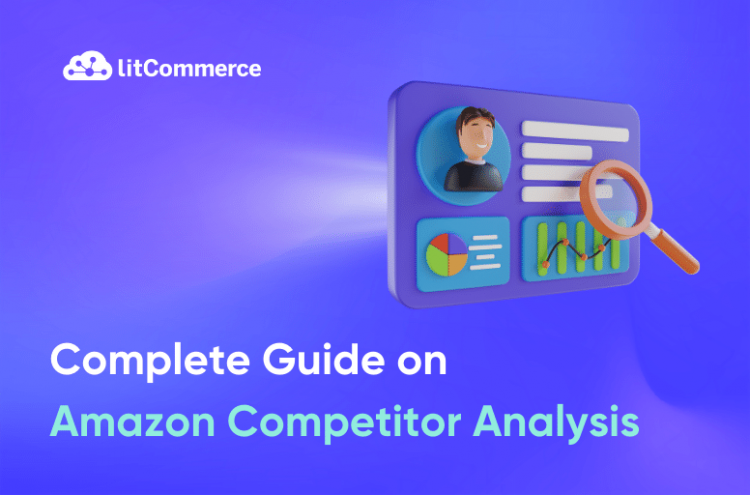Mastering Amazon competitor analysis is crucial whether you’re an established seller or just starting.
For existing sellers, it helps refine strategies by pinpointing strengths and weaknesses compared to rivals, enabling better pricing, marketing, and product adjustments. For newcomers, it offers a strategic blueprint to enter the marketplace effectively.
In this article, we’ll cover the essential factors, help you gain a comprehensive view of your competitive landscape, and make strategic decisions to thrive on Amazon. These factors include:
- Product listings: Discover how competitors craft their product titles, descriptions, and images to attract and convert customers.
- Pricing strategies: Understand how competitors price their products and any strategies they use, such as discounts or bundles.
- Sales performance: Gain insights into competitors’ sales volume and performance through metrics like Best Seller Rank and inventory levels.
- Marketing and advertising: Explore how competitors use Amazon ads and external marketing efforts to boost their visibility and sales.
- Customer feedback: Analyze customer reviews to identify common strengths and weaknesses in competitors’ products.
Let’s check it out!
How Do You Find Your Amazon Competitors?
Finding your Amazon competitors is easier than you might think, and it starts with a simple search. Begin by entering items related to your product or niche directly into the Amazon search bar. The top-ranking products in the search results are your most direct competitors.
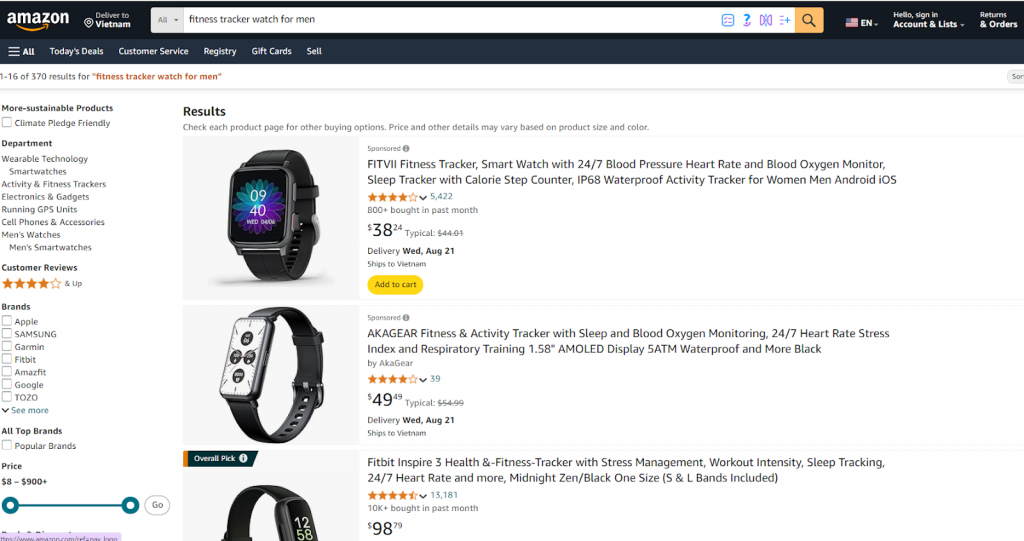
Another effective method is to browse the “Frequently bought together” and “Customers who viewed this item also viewed” sections on your competitors’ product pages. These sections showcase products that Amazon’s algorithm has identified as closely related or similar to yours, offering a clear view of your competition.
To dig deeper, use reverse ASIN (Amazon Standard Identification Number) lookup tools like Helium 10 or Jungle Scout. By entering the ASIN of a product, these tools reveal the keywords for which different sellers rank, giving you useful insights into their SEO strategy.
Next, let’s explore how to conduct Amazon’s competitive analysis
How to Analyze Competitors on Amazon to Beat Them?
Let’s dive into the nitty-gritty of Amazon seller competitor analysis to propel your business to greater profitability.
1. Study the product listings & images
First and foremost, conduct Amazon competitor research by analyzing the product listings of your competitors. By understanding what makes their listings successful, you can enhance your own strategies. Here are the key elements of your competitors’ product listings that you should examine:
1.1. Keywords
Keywords play a notable role in how products are ranked and discovered on Amazon. They determine how easily customers can find your products amidst the vast Amazon marketplace. Here are how to find Amazon competitor’s keywords on Amazon and master keyword analysis:
- Use advanced tools: Leverage tools like Jungle Scout, Helium 10, or AMZScout to uncover high-volume and niche keywords your competitors are targeting.
- Analyze keyword placement: Examine how keywords are used in competitors’ titles, bullet points, descriptions, and backend search terms to optimize your listings.
- Optimize your listing: Integrate keywords strategically into titles, bullet points, descriptions, and backend search terms for maximum visibility and engagement.

1.2. Product titles
The product title serves a dual purpose. It helps your customers find your products and assists search engines in categorizing the product correctly. Analyzing your competitors’ titles can inspire you and help you identify keywords that might drive sales to products like yours. Additionally, consider if there’s any important information missing from your competitor’s headlines that you can include to better inform customers.
1.3. Images
By analyzing your competitors’ images, you can identify what they are doing better than you or what is missing in your product images. Uploading high-quality images that accurately represent your product in real life helps customers visualize it and make informed purchasing decisions.
For instance, if you are selling books on Amazon, your book’s image should be clear, informative, and engaging. Also, they need to be 500×500 or 1000×1000 pixel images to increase listing quality. High-resolution images can significantly enhance the appeal of your listing, making it more attractive to potential buyers.
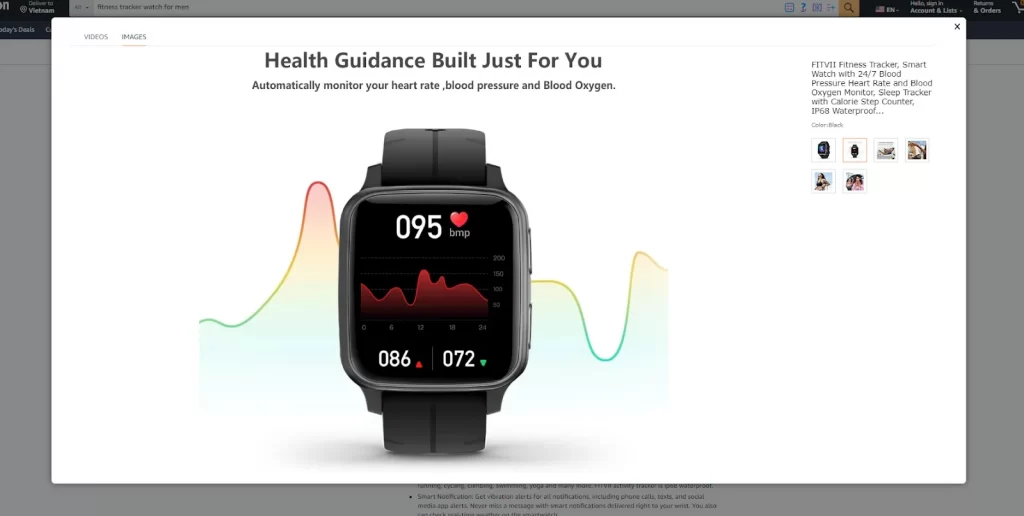
1.4. Bullet points and description
Along with the title, analyzing the description of your competitors is a step you should not skip when conducting an Amazon competitor analysis. You can identify additional information they include and how they present it. Ask yourself:
- Are your competitors providing additional product details that you may have overlooked?
- How do they organize their descriptions to make it easy for customers to read and understand?
- Do they highlight product benefits that you may not have emphasized?
2. Research competitors’ product features
In the journey of Amazon competitor analysis, understanding your competitors’ products inside and out is the foundation of a winning strategy. It reveals what they’re doing right, where they might be falling short, and what opportunities exist for you to stand out.
You need to analyze the following aspects:
- Features and specifications: Carefully compare your product’s features and specs with theirs. You should note any differences, especially if they offer something you don’t or if theirs are superior. This helps you identify your own unique selling points.
- Variations and bundles: See if they offer different product options (like colors or sizes) or bundled deals. This could be a good way for you to expand your offerings and cater to a wider range of customers.
- Value-added services: Check if they provide extras like free shipping, warranties, or top-notch customer support. Adding these perks to your own products could make them more appealing.
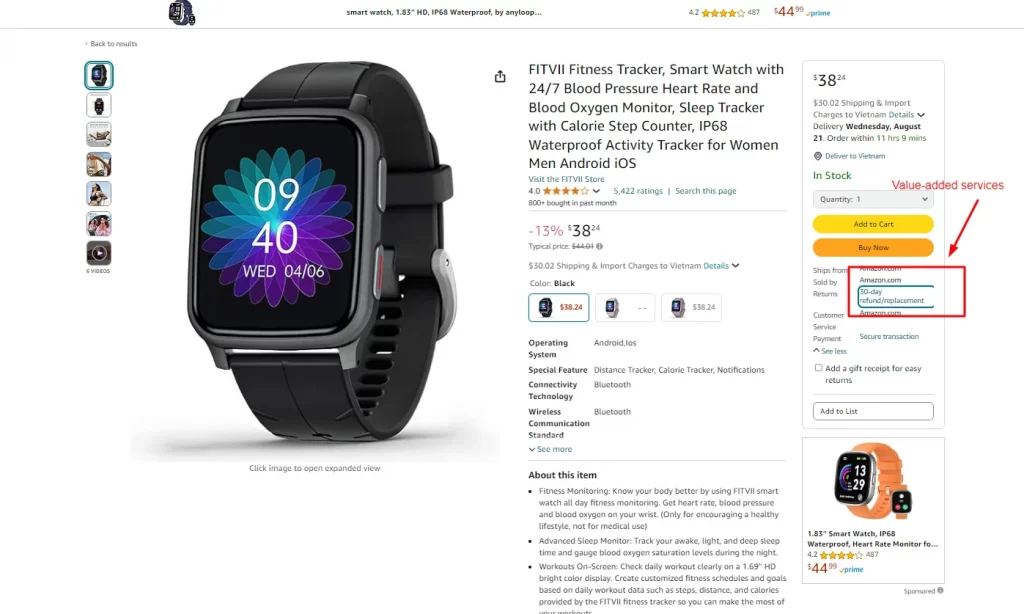
It is a great idea to leverage an Amazon competitor analysis tool to dive deep into product features. Two excellent tools to help you are:
- Helium 10: This comprehensive Amazon seller tool suite offers a powerful feature called “Cerebro” that allows you to reverse engineer your competitors’ keyword strategies. Additionally, Helium 10’s “Scribbles” feature helps you craft compelling product descriptions that highlight your unique selling points and resonate with potential buyers.
- Jungle Scout: Another popular choice among Amazon sellers, Jungle Scout provides a “Product Tracker” feature that allows you to monitor your competitors’ product listings over time. Jungle Scout also offers a “Product Database” where you can filter and search for products based on specific criteria, making it easier to find competitors with similar offerings and compare their features.
3. Track competitor’s pricing
Pricing strategy is a critical component of any Amazon competitor analysis. Customers often compare prices before making a purchase, so understanding how your competitors price their products can provide valuable insights.
Here’s a detailed breakdown of how to effectively track competitor pricing manually:
- Create a tracking system: Set up a spreadsheet or document to record competitor prices. Include columns for the product name, competitor name, date, price, shipping cost, any promotions or discounts, and additional notes. You can also use a dedicated note-taking app or project management tool to organize your tracking efforts.
- Regularly check prices: Schedule regular checks of your competitor’s product pages.The frequency will depend on your industry and how often prices tend to fluctuate. Daily or weekly checks may be sufficient for some products, while others might require more frequent monitoring.
- Record price changes: Update your tracking system whenever you notice a price change on a competitor’s product. It would be better to note the date and time of the change, as well as the new price.
- Analyze price trends: Over time, you’ll start to see patterns in your competitor’s pricing strategies. You should analyze the data you’ve collected to identify trends, such as when they typically raise or lower prices, or if they often run promotions or discounts.
However, we note that manual analysis is economical but often time-consuming. If you have the budget for it, automated Amazon competitive analysis tools can save you time and offer a more detailed evaluation of competitors’ pricing on Amazon. Some highly recommended tools include:
- Keepa: This tool allow you set up price alerts to be notified when a competitor changes their price. And, you can even see historical sales rank data to get an idea of how price changes have impacted sales.
- CamelCamelCamel: It has a handy feature called “The Camelizer,” a browser extension that lets you view price history charts directly on Amazon product pages. Additionally, CamelCamelCamel lets you create price watches for specific products, so you’ll be notified when they go on sale or drop below a certain price.
Useful note: Competitive pricing doesn’t always mean having the lowest price. It’s about finding the right balance between price and perceived value. If your product offers unique features or superior quality, you can justify a higher price point. Conversely, if your product is similar to competitors, you might need to adjust your pricing strategy to remain competitive.
4. Analyze sales performance
In your Amazon competitor analysis journey, don’t forget to evaluate sales performance. While you can’t see the exact sales numbers of competitors, you can get a good idea of how well your competitors are doing. This helps you benchmark your performance and set realistic goals.
Manually tracking your competitors’ sales performance can be challenging. Instead, leveraging specialized tools can simplify the process. Notable options include:
- Viral Launch: This platform offers a suite of tools for Amazon sellers, including a “Market Intelligence” feature that provides in-depth sales estimates and competitor analysis. Viral Launch’s “Competitor Intelligence” tool allows you to track your competitors’ daily sales.
- AMZScout: With its “PRO Extension,” AMZScout allows you to see estimated sales data directly on Amazon product pages. It also offers a “Product Database” where you can filter and search for products based on various criteria, making it easy to find competitors and analyze their sales performance. AMZScout also has a “Sales Estimator” tool that helps you predict potential sales for your products based on market trends and competitor data.
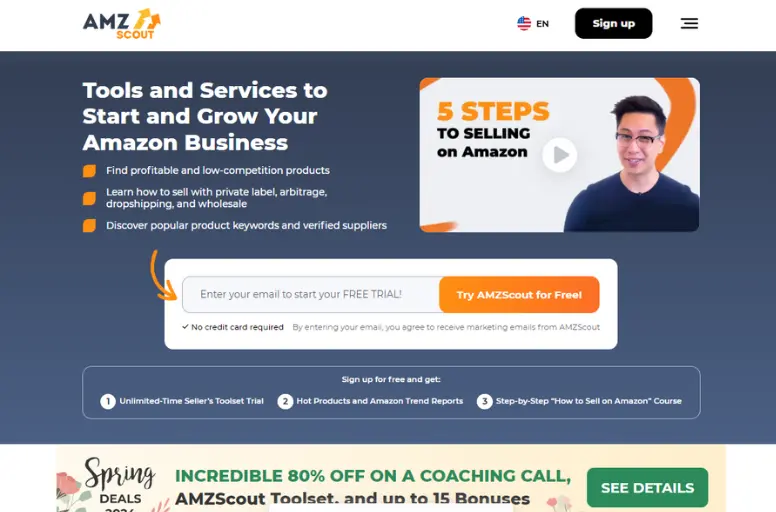
5. Read customer reviews of your Amazon competitors
Customer reviews are a goldmine of information in Amazon competitor analysis. They reveal what customers love and hate about your competitors’ products, giving you a roadmap to improve your own.
When evaluating customer feedback, be mindful of the following points:
- Product quality: Look for patterns in the input. Do people rave about how well-made or easy-to-use the product is? Or do they complain about flaws? This helps you figure out where your competitors are strong or weak.
- Feature requests: Customer reviews often contain valuable suggestions and feature requests. By incorporating popular feature requests into your own product, you can cater to customer desires and potentially capture a larger market share. Additionally, monitoring review trends over time can help you anticipate future customer needs.

We note that annually, reading through hundreds of reviews can be time-consuming. Fortunately, several Amazon competitor analysis tools can help streamline the process. These two exceptional tools are highly recommended:
- FeedbackWhizz: This tool employs natural language processing (NLP) algorithms to automatically determine whether a review is positive, negative, or neutral. Moreover, it can help you group reviews based on common themes and keywords. Then, you can identify specific aspects of your product that customers frequently mention.
- AMZFinder: It tracks and aggregates customer reviews from multiple Amazon marketplaces worldwide. Then, it provides detailed reports on various aspects of customer reviews, such as average star ratings, sentiment trends over time, and the most frequently used keywords.
6. Explore competitors’ advertising strategies
The final stage of your Amazon competitor analysis involves examining your competitors’ advertising strategies. Knowing how your competitors are advertising helps you refine your marketing efforts and reach the right customers.
Here are which elements you should analyze:
- Advertising channels: See what types of ads they’re using on Amazon (Sponsored Products, Sponsored Brands, Display Ads). You should look at their ad text, who they’re targeting, and how much they’re bidding.
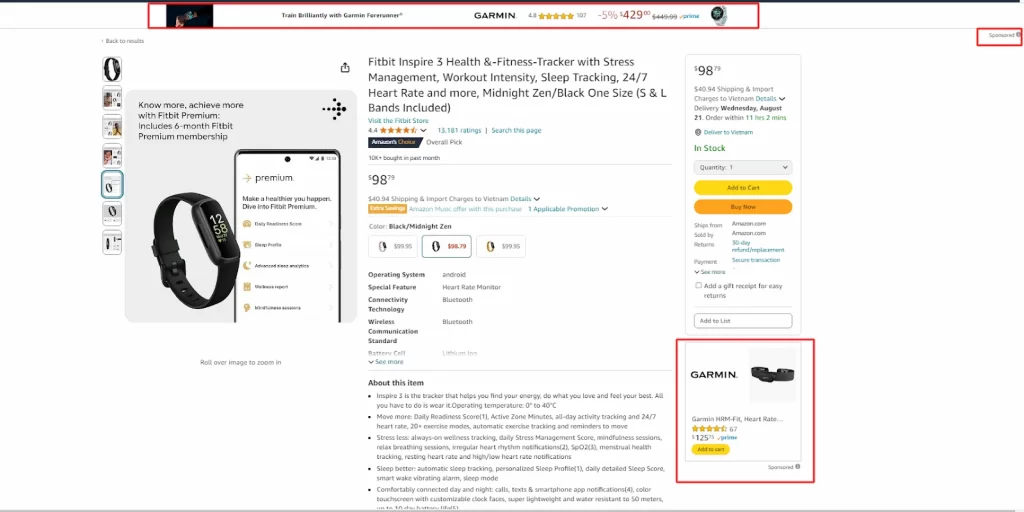
- Beyond Amazon: Check out their social media presence and other marketing efforts (like email campaigns or influencer partnerships). This gives you ideas for expanding your reach.
- Promotions and deals: Keep an eye on any special offers they run, like discounts or bundles. This helps you understand what attracts customers and plan your own promotions.

Now, we have many Amazon competitor analysis tools that can aid your exploration of competitors’ marketing and advertising strategies, such as:
- Brand Analytics (for Brand Registered Sellers only): This free Amazon tool shows which keywords competitors bid on and their performance, including impressions, clicks, and conversions, plus insights into Sponsored brand campaigns
- Ad Badger: This platform provides tools for Amazon PPC advertisements. This includes identifying competitors’ keywords and spending, analyzing their ad copy, and estimating their advertising profitability to evaluate campaign effectiveness
What to Avoid When Conducting Amazon Competitor Analysis?
How can you expect to gain a competitive edge without performing an Amazon competitor analysis? However, it’s essential to be aware of common pitfalls in competitive analysis. Here are some mistakes to avoid to improve your product, boost sales, and strengthen cross-team collaboration.
- Don’t solely focus on the top sellers. While they might seem like the biggest threat, there are often smaller, niche sellers with unique strategies that could offer valuable insights.
- Avoid relying on outdated data. The Amazon marketplace is dynamic, and what works today might not work tomorrow. Use tools that provide real-time data on sales, keywords, and pricing to ensure your analysis is accurate and relevant.
- Steal like an artist; don’t just copy your competitors. While learning from their successes is wise, blindly mimicking their strategies won’t differentiate your brand or product. Instead, use the analysis to identify gaps in the market or areas where you can offer something unique.
- Remember to underestimate the power of qualitative analysis. While data is crucial, customer reviews and social media chatter can provide valuable insights into customer sentiment, product issues, and emerging trends.
Top 4 Amazon Competitor Analysis Tools
The remarkable expansion of Amazon, renowned as one of the top marketplaces for selling products, has spurred the development of numerous Amazon competitor analysis tools specifically tailored for Amazon. To assist you in this endeavor, we present a few recommendations, regarding tools for Amazon competitor analysis:
1. Jungle Scout
Jungle Scout is an Amazon competitor research tool designed to help sellers make informed decisions about their products. The tool provides valuable insights to help sellers optimize their sales and stay ahead of the competition.
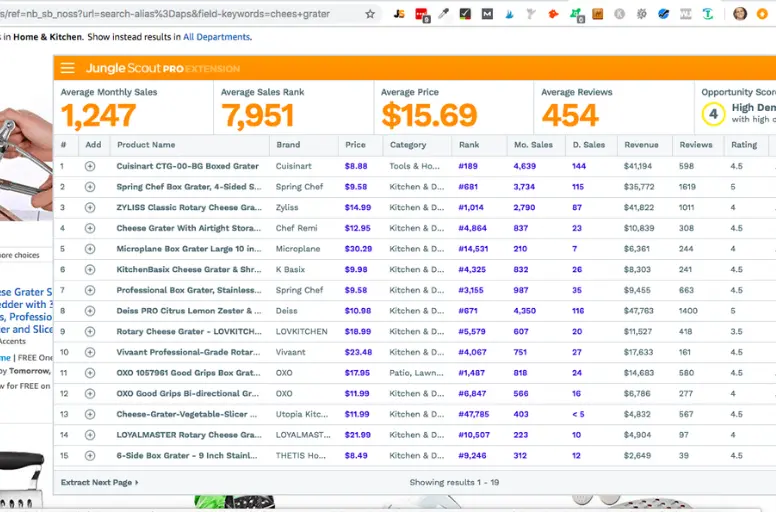
One of the primary ways Jungle Scout helps its users is by providing a thorough analysis of competitors on Amazon. This includes valuable information such as sales data, search volume, and customer reviews. With this information, sellers can determine the viability of their products, make data-driven decisions on pricing and marketing strategies, and adjust their listings accordingly.
Pros:
- Comprehensive competitor analysis helps sellers stay ahead of the competition
- Robust sales data and other metrics provide valuable insights for optimization
- Easy-to-use interface with a customizable dashboard
- Offers both web app and Chrome extension options
- Helpful customer support and educational resources are available
Cons:
- Can be expensive for small businesses and new sellers
- Some users report inaccuracies in the data
- May take time to master the platform and make the most of its features
Pricing for Jungle Scout varies depending on the specific plan chosen. The web app offers three pricing options: Basic, Suite, and Professional, ranging from $49 to $129/month. The Chrome extension offers two pricing options: Lite and Pro, ranging from $19 to $39/month. Ultimately, the pricing may be a consideration for those who are just starting or selling only a few products.
2. Seller App
The Seller App tool is an Amazon competitor analysis tool designed to help sellers analyze and optimize their product listings. Its key features include inventory management, profit calculation, and competitor analysis.
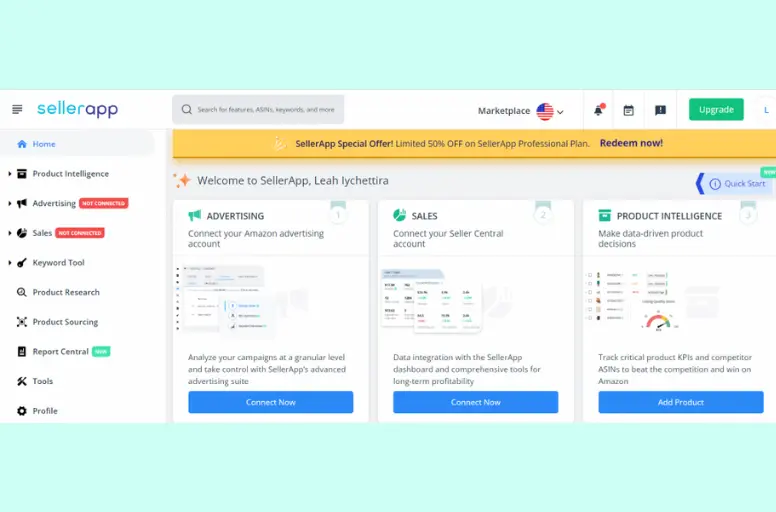
When it comes to competitor analysis, the Seller App tool provides essential data such as seller ranking, sales volume, ratings, and reviews. This competitive intelligence helps sellers understand how they stack up against their competition, and make informed decisions about pricing, marketing, and product optimization.
Pros:
- Real-time data tracking enables timely decisions
- User-friendly interface requires no prior experience
- Offers valuable insights on product ranking, ratings, and customer feedback
- Helps identify profitable product niches and market trends
- Affordable pricing options for small and large businesses alike
Cons:
- Lacks some advanced features of more expensive software
- Only compatible with Amazon marketplaces
- Some users report issues with data accuracy
Pricing for the Seller App tool is tiered, offering Basic, Professional, and Premium subscription plans starting at $14.99 per month. This makes Seller App a viable option for small businesses and new sellers that may not have the resources for more advanced analytics tools. However, as the needs of the business grow, it may be necessary to upgrade to more full-featured software to gain a better understanding of the competitive market.
3. AMZ Scout
AMZ Scout is an Amazon competitor analysis tool designed to help sellers identify profitable products and optimize their Amazon listings. The tool provides valuable data insights that enable users to make data-driven decisions, such as product research, competitor analysis, and sales tracking.
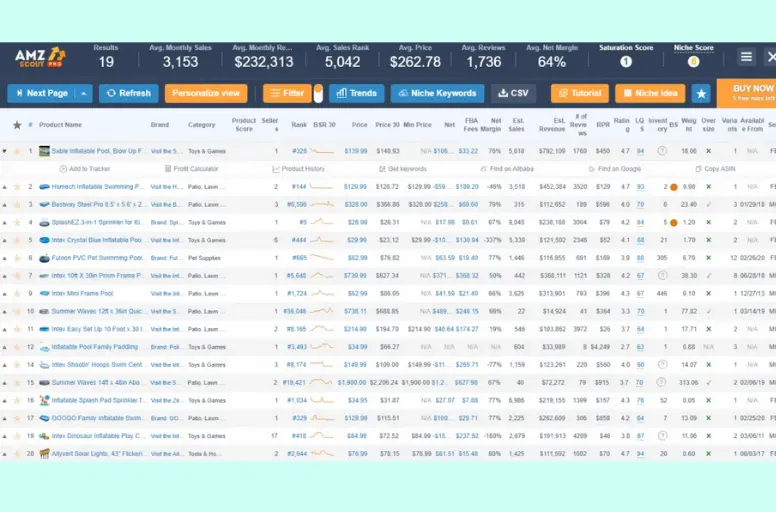
One of the key ways that AMZ Scout helps with competitor analysis on Amazon is by providing insightful data on competitor products. This includes information such as sales volume, customer reviews, price comparisons, and search terms. By analyzing this data, sellers can gain an understanding of what products are trending, and what price points are popular and optimize their listings to stay ahead of the competition.
Pros:
- Comprehensive competitor analysis helps sellers stay ahead of the competition
- Powerful product research features provide valuable insights for the optimization
- Easy-to-use interface with a customizable dashboard
- Offers both web app and Chrome extension options
- Provides helpful customer support and educational resources
Cons:
- Expensive for smaller businesses and new sellers
- Some users report inaccuracies in the data
- May take some time to master the platform and make the most of its features
Pricing for AMZ Scout is tiered, offering Basic, Start, Business, and Enterprise subscription plans ranging from $29.99 per month to $299.99 per month. This pricing structure provides businesses of all sizes with entry-level and advanced features with affordable pricing options. Furthermore, the Chrome extension version is available as a free version, and the company offers a 7-day free trial of their web app version.
4. ZonGuru
ZonGuru is an all-in-one Amazon seller tool that offers an array of features to help sellers grow their businesses. It offers several features such as product research, keyword research, listing optimization, email automation, and inventory management.
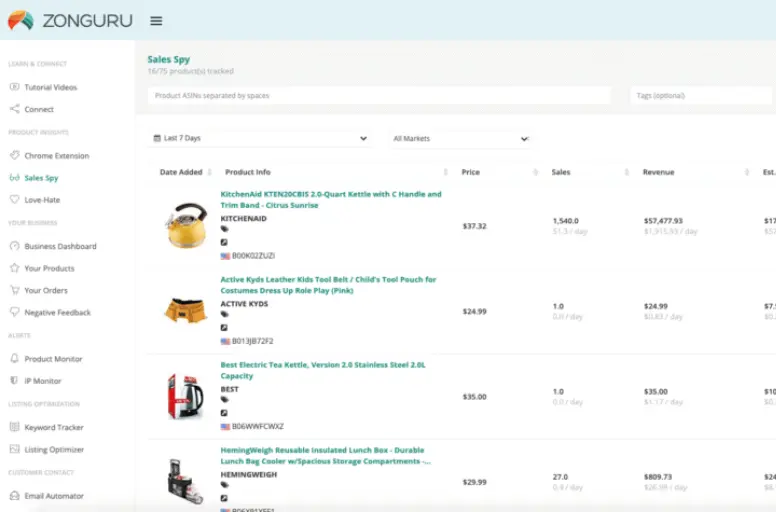
One of the primary ways that ZonGuru helps with competitor analysis on Amazon is by providing an in-depth analysis of competitors’ listings. This includes competitor sales volumes, rank tracking, review tracking, and potential keywords. This allows sellers to gain an understanding of how their competitors are performing, what is driving their sales, and how they can adjust their marketing and pricing strategies to stay competitive.
Pros:
- Offers a variety of tools for different stages of the sales process
- Provides comprehensive competitor analysis for data-driven decision-making
- Helps optimize listings for better visibility and sales
- Extensive keyword research capabilities
- Offers excellent customer support with dedicated account managers
Cons:
- More expensive than some alternative tools
- Some features are only available in higher-priced plans
- Some users report glitches within the platform
Pricing for ZonGuru is also tiered, offering Starter, Business, Business Plus, and High Volume subscription plans ranging in price from $47.99 – $599.99 per month. This means it may be a bit pricey for smaller businesses just starting on Amazon. However, for larger businesses and established online sellers, ZonGuru offers a considerable variety of tools for them to scale and optimize their Amazon listings effectively. Interestingly, ZonGuru also offers a 7-day free trial, where users can try all the features and a return policy for users unsatisfied with the platform.
Amazon Competitors Analysis – FAQs
Amazon competitor analysis involves identifying and evaluating similar businesses to understand their strengths, weaknesses, strategies, and market positioning. This helps sellers gain insights, identify growth opportunities, and make informed decisions about product development, pricing, and marketing to succeed in the marketplace. Analyzing competition on Amazon involves several steps: While monitoring competitors is essential, over-reliance on their strategies can hinder innovation and lead to a copycat approach. It’s important to focus on your unique value proposition and differentiate yourself. Additionally, excessive focus on competitors can distract from your core business goals and lead to unnecessary price wars or marketing tactics. Strive for a balance between monitoring and focusing on your own growth and development.
Conclusion
In conclusion, conducting an Amazon competitor analysis is vital in today’s competitive market. By decoding your competitors, you can gain valuable knowledge about their strategies, strengths, weaknesses, and market positioning. This information allows you to make informed decisions, identify market gaps, and differentiate yourself. Regularly updating your analysis is essential to stay responsive to changes in the market.
To guarantee that your business decisions are beneficial, we invite you to join our Retailers Blog and Facebook community. By doing so, you can remain informed about the most recent trends and developments in the eCommerce industry. This knowledge will enable you to adapt and thrive within the industry, accelerating the growth of your business. If you require additional support, please don’t hesitate to reach out to LitCommerce.

